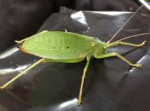 Most people have heard of katydids but when was the last time you saw one? They have a distinct sound and perhaps you have listened to it in the evening when they get revved up. They are not common garden visitors, at least not when you are out gardening. Every wonder why?
Most people have heard of katydids but when was the last time you saw one? They have a distinct sound and perhaps you have listened to it in the evening when they get revved up. They are not common garden visitors, at least not when you are out gardening. Every wonder why?
Here are ten interesting facts about katydids that will explain some of the whys and wherefores.
1. Katydids are relatives of grasshoppers but can be distinguished from them by their long antennae.
2. The wings of katydids are usually green with markings that make them resemble leaves so that it is difficult for their predators to recognize them.
3. Katydids are nocturnal so don’t expect to see a lot of them during the day.
4. Katydids live in bushes and the canopy of trees, especially oaks, where they eat the leaves. Sometimes they eat dead insects and aphids.
5. Males make their distinctive sound by rubbing the scraper on one forewing against the toothed edge of the other forewing as part of their mating ritual. Katydids get their name from this sound, “katy-did’.
6. Katydids complete only one life cycle per year. Females deposit their eggs by means of a special structure called an ovipositor on leaves or in the cracks of bark in the fall. The eggs over-winter and hatch into miniature katydids in spring.
7. Katydids don’t usually fly; they may flutter downward but once they land they climb back upward.
8. In the tropics katydids can live for several years but elsewhere they generally live just one year. Only their eggs can get through the winter.
9. There are over 2,000 different kinds of katydids in the tropics and about 200 in North America.
10. In general, katydids live apart from humans but sometimes they become pests and eat crop plants.
Most of us will hear but not see katydids because of their nocturnal and arboreal nature. Too bad. These insects are slow moving and very interesting to examine. They are not aggressive and tolerate a bit of prodding so are a good insect to introduce to children. Although they can’t be classified as “beneficial insects” they do most of us no harm and are enjoyable when we are lucky enough to come upon them.
